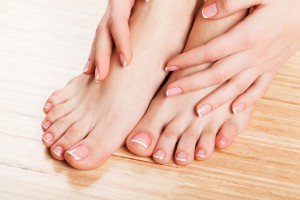If you do ballet, you use your feet more than the average person. Here is an article especially devoted to you on how to care for ballet feet.
They say that Ballet dancers have really ugly feet.
This need not be the case if you give them some care and attention. Remember that if you treat your feet well, they will continue to work for you forever. If you ill-treat them or put them in shoes that don’t fit, you can expect them to play up, not only in your ballet dancing but on a day-to-day basis. Here are some basic habits to instill that is necessary to ensure the longevity of your hard-working feet – especially for the ballet dancers out there.
How To Care For Ballet Feet
- Make sure to properly clean and dry your feet each day. This includes washing between the toes. Don’t over soak your feet, or you will over soften the calluses that you need to protect your feet.
- After ballet, it is a good idea to work some oil into your foot and give yourself a foot massage at the same time.
- Toenails need to be trimmed straight across on the short side, but be careful of cutting them too short. Never cut the corners or sides or you could encourage ingrown toenails. If you do get ingrown toenails soak them in warm water and then place thin bits of cotton under the edges of the nail before doing your pointe work ballet class. See a doctor for advice if the problem persists.
- How to care for ballet feet when doing pointe work is to protect your big toe and give it some cushioning, or you could get bruised toenails. Bruised toenails are caused by the big toe striking or pressing against the front of your pointe shoe. The nail will turn blue or black and sometimes fall off. If this happens you will find it very difficult and painful to do your pointe work until the nail grows back.
- Most dancers will get blisters at some time or another. These are caused by friction, and they can be a nuisance. Try and prevent these by taping the areas that you know rub against your shoe. You can also surround the blister with a doughnut made from foam or gel, which will prevent the shoe pressing on the sore spot. Make sure that your shoes fit well. Even your street shoes shouldn’t rub you anywhere. Witchhazel nut oil massaged into your feet each night should help you to prevent blisters, as it thickens and softens the skin.
- Calluses are hardened skin that forms from using your feet too much. Problems arise here when thick calluses crack open and leave a painful raw area that is prone to infections. If you get calluses, do not cut them, rather treat them gently with a pumice stone. Professional care is also an option. Most dancers and ballet dancers will need some calluses to protect their feet, just don’t let them get of hand.
- Corns are also another common foot problem and can develop anywhere on the foot where the bones rub against each other or even your shoes. Soft corns are usually found between the toes and are normally caused by wearing shoes or pointe shoes that are too tight. Not wearing tights with your shoes could also aggravate the problem. If you have a weakness in your foot, this could also increase pressure on certain parts of your foot causing corns. Padding the relevant areas can help, but visit your podiatrist if the problem persists, as if the corn gets too big it can be very uncomfortable.
- Always wear fresh clean socks or tights that fit properly, and never put on sweaty shoes. Let them dry out properly before wearing them again.
How To Care For Ballet Feet With Some Great Products
Here is a great selection of products for dancers’ feet. To find out about any of the products, simply click on them. These are the ultimate spoil if you want to know how to care for dancers’ feet. If you would like to find out how to care for ballet feet using any of these products, simply click on your product of choice to find out more.







